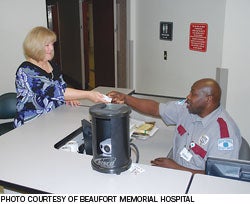Visitor management system keeps tabs on past violators
 |
| After-hours visitors at Beaufort Memorial Hospital get a special pass to enter. |
It's no surprise that a new after-hours visitor management system recently implemented at Beaufort (S.C.) Memorial Hospital has added an extra level of security after regular visiting hours. The new program also has resulted in other unexpected benefits that help keep staff and patients safer.
The new system, called Fast-Pass and made by Security Identification Systems Corp., West Palm Beach., Fla., requires that visitors who go to Beaufort Memorial from 9 p.m. to 6 a.m. enter the hospital through the emergency department as the main entrance is locked. A security officer verifies visitors' identifications by swiping the bar code on their ID card, such as a driver's license, into a computer system that maintains a database of visitors.
Security staff take visitors' pictures and issue them a 3-inch-by-5-inch glue-backed paper badge that is valid for up to eight hours. The badge has the visitors' photos, names and the location within the hospital they are permitted to visit. Staff then can determine if security has approved the person for visiting and in which area.
If someone is disorderly while at the hospital and returns at a later date, the security officer knows about the incident because of the database, says Doug Rhodin, director of security and central transportation at the hospital. The security department knows to deny entry to the previously unruly visitor, he says.
So far the system has been an unqualified success and is supported by visitors and staff alike. In addition, Fast-Pass has had an unexpected but welcome impact, Rhodin notes.
Before implementing Fast-Pass, some disruptive visitors entered the ED while intoxicated and behaved in a hostile manner toward staff, although he says those incidents were rare. "Now that we have their identification and we scan them in the system, visitors' behavior has improved," Rhodin says.
The cost to set up Fast-Pass was about $12,000, with most of the money going toward the camera, photo printer and software, he says. From all accounts, it's been a smart investment.




